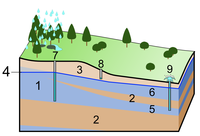
Photo from wikipedia
Abstract Deformation and breakup of a liquid drop immersed in another immiscible liquid and flowing through a single pore has been studied numerically using a conservative phase-field lattice Boltzmann method.… Click to show full abstract
Abstract Deformation and breakup of a liquid drop immersed in another immiscible liquid and flowing through a single pore has been studied numerically using a conservative phase-field lattice Boltzmann method. Several benchmarks were conducted to validate the code, including the recovery of Laplace pressure, the layered flow of two immiscible liquids, and the implementation of wetting boundary conditions on a curved surface. Gravity-driven motion of a drop through the pore space was qualitatively compared to the available experimental results. Quantitative assessment of the pressure field across the interface of the moving and deforming drop was performed. Our results show that high Weber number due to low surface tension and low Reynolds number due to low velocity of the continuous liquid promote drop breakage. More viscous drops break easier than less viscous drops. We present the phase charts (Weber vs capillary number) and the critical conditions (Weber as a function of Reynolds number) of drop breakage.
Journal Title: Chemical Engineering Science
Year Published: 2021
Link to full text (if available)
Share on Social Media: Sign Up to like & get
recommendations!